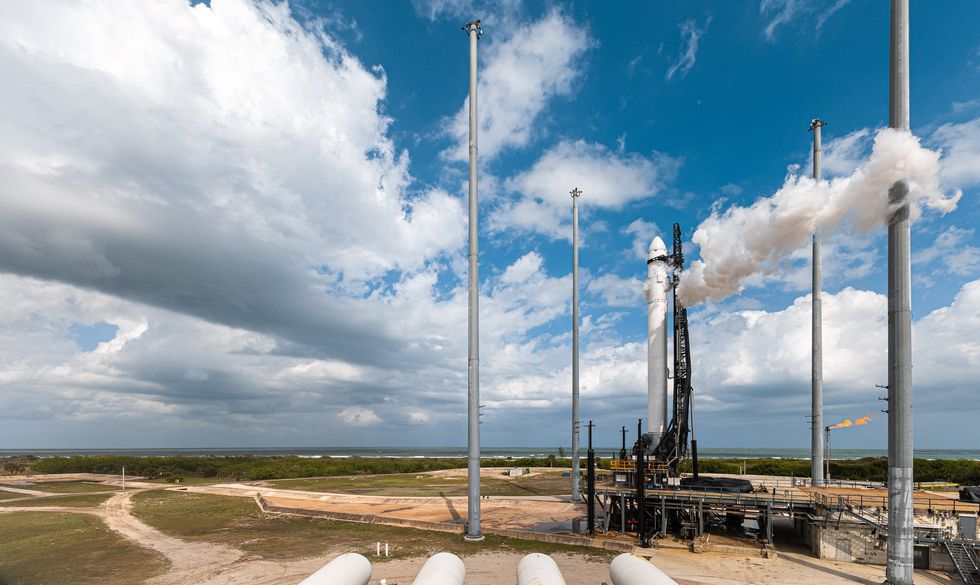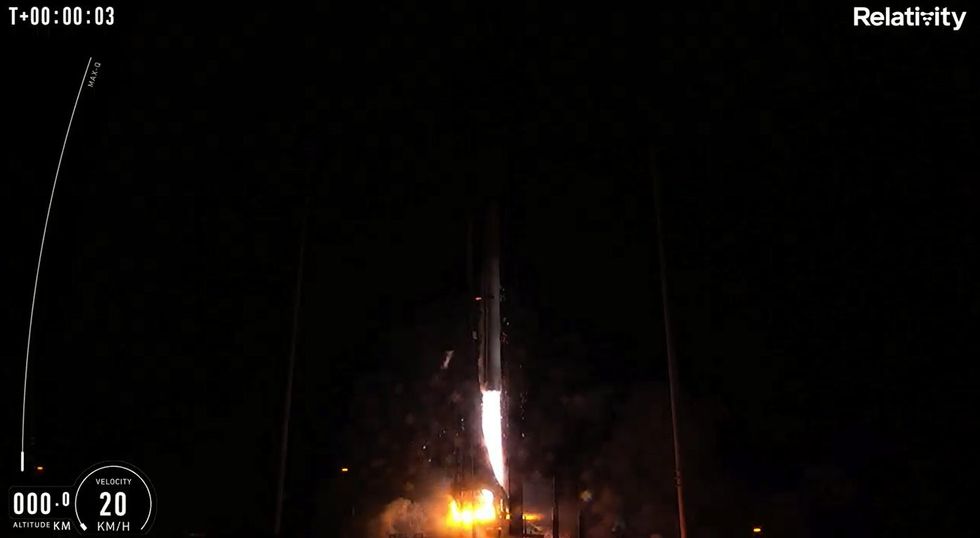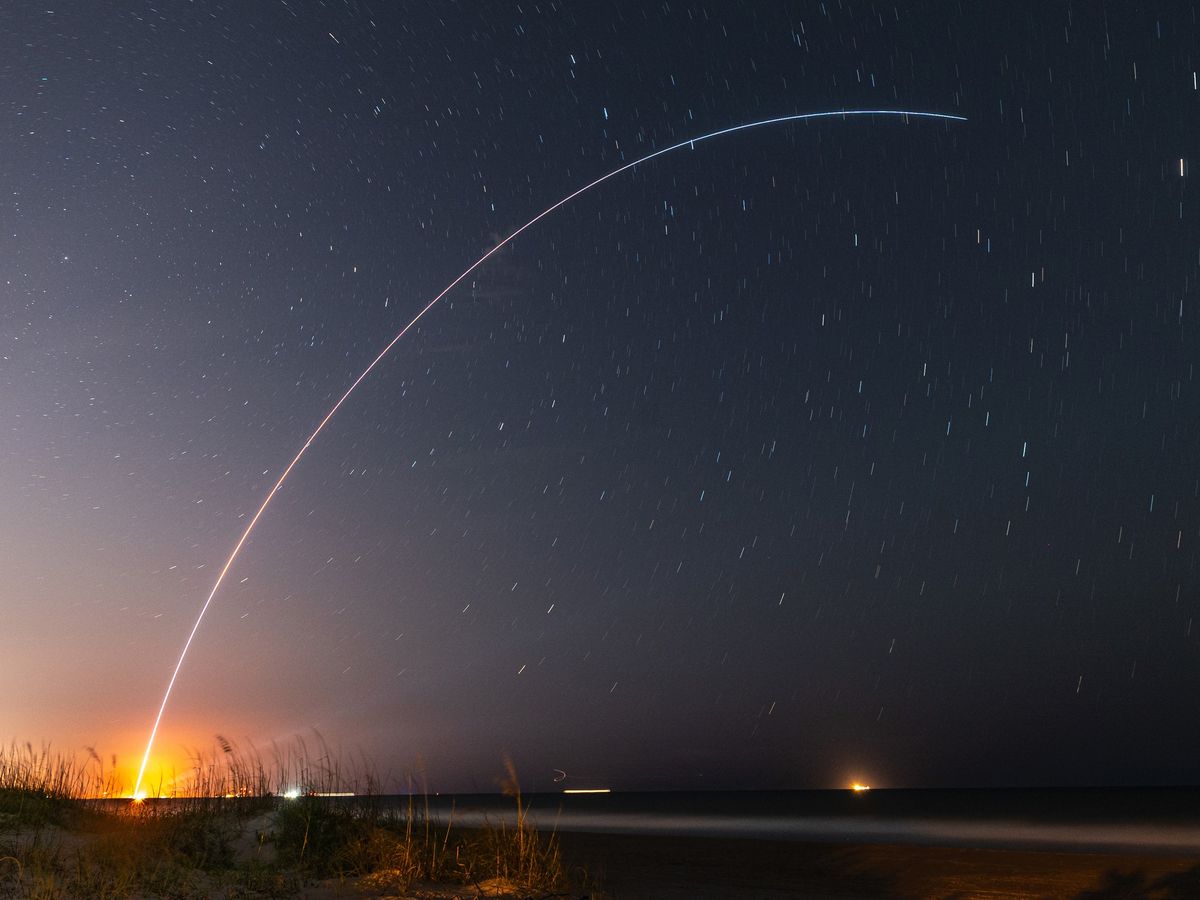Space is hard. Every time a rocket crashes or a probe goes silent, someone invokes the mantra that it’s hard to reach for the stars. Rockets are complicated machines, often with thousands of parts that can doom a mission if just one fails.
Relativity Space, a California-based startup, is trying a new approach—3D printed rockets to simplify the assembly and structure of launch vehicles. Late Wednesday night it had, by its own description, a partial success. Its first Terran 1 rocket lifted off from Launch Complex 16 at Cape Canaveral in Florida, and its first stage carried it nearly 100 kilometers toward orbit. But apparently something went wrong with the second stage as it tried to start, and the rocket’s remains fell into the Atlantic.
“Look at that blue fire!” yelled a launch commentator on the company’s webcast of the launch as the methane-fueled rocket streaked into the sky. Two minutes and 40 seconds after launch, the first stage shut down on schedule and dropped away. Video from a camera on the second stage showed its engine ready to go. But then, a moment later, the voice of launch director Clay Walker could be heard: “T-plus anomaly with stage two.”
“Today is a huge win, with many historic firsts,” said the company in an upbeat tweet after the launch attempt was over. How so? “We successfully made it through Max-Q, the highest stress state on our printed structures. This is the biggest proof point for our novel additive manufacturing approach.”

The company said it would go through the data it had gathered during the flight and provide updates in the coming days. It did not immediately offer further details.
In fairness, no private space company has made it to orbit on its first try, and Relativity had been trying for months to play down expectations for the Terran 1. This first mission, nicknamed “Good Luck, Have Fun” (GLHF for short), carried no payload.
How would Relativity define success? “We’ll let our customers answer that,” said Josh Brost, Relativity’s head of business development, in an interview with IEEE Spectrum last November, while GLHF was being prepped for flight.
Relativity says that about 85 percent of its first rocket by mass was 3D printed, and the company eventually hopes to raise that to 95 percent. Additive manufacturing offers many advantages. The first is that the Terran 1 probably has one-hundredth the number of parts that make up a conventional rocket of similar capability—which means vastly fewer seams, fewer spot welds or bolts to hold pieces together, and fewer joints in propellant lines. In sum, there are fewer components to make and fewer places where failures can occur.
“The real thing we’re looking to get from the first launch is validating that a 3D printed rocket can survive the rigors of the launch environment,” said Brost. “We’re collecting as much data as we can to help our engineers validate or improve what they’ve developed over the last few years on the ground.”
Building a 3D printed rocket, says the company, is dramatically different from what one would see on conventional aerospace assembly lines. Instead of milling and bending with exacting labor to shape thousands of components, the primary tool is a robotic arm, adding liquified or powered metal alloys, layer by layer, to whatever part of the vehicle is being fabricated.
Just as an example, a rocket nozzle often has a complicated network of coolant pipes surrounding it, with cryogenic propellants pumped through to keep the nozzle from overheating when the fuel is pumped into the combustion chamber and ignited. That’s a tall order. The coolant lines need to be intricate and sturdy, lightweight, and well-insulated, all at the same time. The result is that traditional booster engines can have more than a thousand parts. Relativity says its engines have a fraction as many.

Three-D printing also makes modifications easier and far faster. Presuming that Relativity can determine what went wrong with the second stage, the team there says they may not have to rebuild from scratch. Instead, they’ve said, with some application of artificial intelligence, they can change the software commands for the 3D printing of future rockets they assemble.
Relativity has said it is using the Terran 1 as a test bed; if it’s successful, it will move on to a larger rocket, dubbed the Terran R, which it says can carry 20,000 kilograms of payload into low Earth orbit. The company says it has several orders from satellite makers who want to use it. And further out—way further out—it talks about taking fuller advantage of its technology. If 3D printing can be used to fabricate launch rockets on Earth, can it be used to make habitats on Mars? It’s certainly not a realistic proposition yet, but in the early years of SpaceX, Elon Musk made it an animating force in his company’s efforts to venture into the skies.
“We believe that we’re participating in the excitement of the new space industry,” said Scott Van Vliet, Relativity’s head of software engineering, “and we’re disrupting traditional mechanisms for building and launching vehicles.”
- Relativity Space and Ellume Garner IEEE Spectrum Awards ›
- Q&A: How 3D Printing Can Enable On-Demand Space Launches ... ›
- Startup Aims to 3D Print Cheaper, Lighter Rockets - IEEE Spectrum ›
- Relativity Space Aims for Orbit ›
- Relativity Space - IEEE Spectrum ›
- Terran R Rocket from Relativity Space Will Be Completely 3D ... ›
- The World's Largest 3D Metal Printer Is Churning Out Rockets - IEEE ... ›
Ned Potter is a New York writer who spent more than 25 years as an ABC News and CBS News correspondent covering science, technology, space, and the environment.


